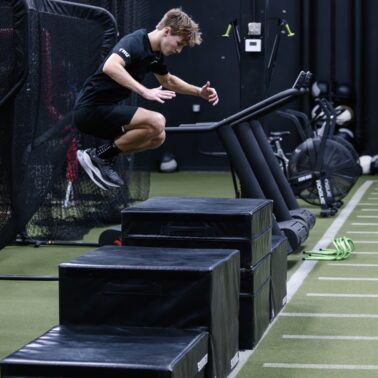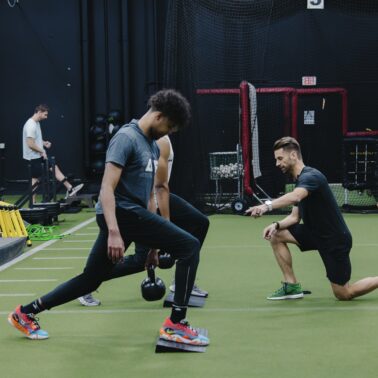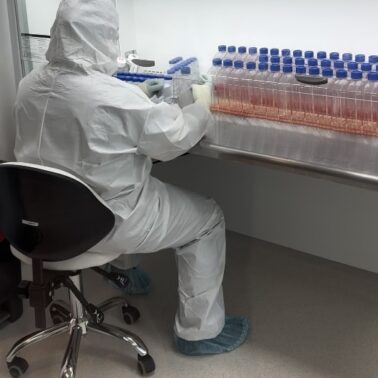“Artificial intelligence has the capabilities to put a physical therapist in everyone’s pocket.”
Adam Loiacono
What You will Learn
- What is motion capture and what are the main types.
- How motion capture can be used within high performance.
- Companies or apps to follow to learn more.
Introduction
In the ever-evolving landscape of sports technology, motion capture (mocap) systems have emerged as a pivotal tool for elevating athletic performance. Originally a staple in the entertainment industry for animating characters, mocap has now found a critical place in sports, providing invaluable insights into athlete biomechanics. This technology is revolutionizing how coaches, athletes, and therapists understand and enhance movement efficiency and safety.
Overview of Motion Capture Technology
Motion capture involves the precise recording and analysis of movement. In sports, it translates to an intricate understanding of an athlete’s motion, offering a window into their biomechanics. The evolution of mocap in sports reflects a journey from complex, bulky setups to sophisticated, user-friendly systems. This shift not only represents technological advancement but also the growing importance of data-driven performance enhancement in sports.
Types of Motion Capture Systems
There are two primary types of motion capture systems used in sports:
- Marker-based Motion Capture: These systems use small sensors or markers attached to an athlete’s body. Cameras track these markers to capture movement. The precision is high, but the setup can be cumbersome and restrict natural movement.
- Markerless Motion Capture: These systems do not require physical markers. Instead, they use advanced algorithms and camera technology to track the athlete’s movement. This method offers more natural movement capture, though it may sometimes lack the precision of marker-based systems.
Marker-based systems excel in precision but can be intrusive and expensive. Markerless systems, on the other hand, offer ease of use and greater comfort for athletes, making them ideal for natural movement analysis, though they might sometimes compromise on minute detail accuracy.
Applications in Sports, Training, & Rehab
In the world of sports and rehabilitation, motion capture technology stands as a beacon of innovation, dramatically transforming how we approach training, performance enhancement, and injury recovery. This cutting-edge technology, once predominantly used in the film and gaming industries, is now a game-changer in sports science and physical therapy.
At its core, motion capture involves tracking and analyzing body movements with incredible precision. For athletes, this means a deeper understanding of their biomechanics, leading to performance optimization that was once unimaginable. Coaches and trainers leverage this data to refine techniques, enhance training programs, and identify potential areas for injury prevention. The ability to analyze movements in real-time allows for immediate feedback, making training sessions more efficient and effective.
In the realm of physical therapy and rehabilitation offers new avenues for recovery and assessments. By accurately assessing movement patterns, therapists can design tailored rehabilitation protocols, ensuring a more efficient and safer recovery process. It empowers therapists to pinpoint specific areas of weakness or imbalance, making interventions more targeted and successful.
This technology is not just about enhancing athletism; it’s about nurturing a deeper connection between the body and its movements, opening new doors in sports training and rehabilitation. Motion capture technology is more than a tool; it’s a bridge to peak performance and faster, smarter recovery.
Key Players in the Motion Capture Industry
- KinaTrax: It is heavily used in professional baseball for analyzing pitcher and hitter performance, employing markerless motion capture technology. KinaTrax utilizes multiple high-speed cameras for detailed 3D kinematic reconstruction, making it ideal for in-depth sports biomechanical analysis.
- Uplift: Uplift’s technology is focused on capturing full 3D athletic movements using two iPhones or iPads. It offers AI-powered insights for sports performance and medicine, aiming to optimize human movement with accessible technology.
- OpenCap: Developed at Stanford University, it’s an open-source software that uses smartphone videos to compute skeletal motion and musculoskeletal forces. This open-source aspect and the focus on using accessible devices like smartphones make it unique among these technologies.
- VueMotion: It focuses on analyzing running and sprinting mechanics, using smartphone technology for capturing motion. This makes it accessible and practical for a broad range of users, including athletes and coaches.

(above photo) a sample of what VueMotion looks like.
Potential shortcomings of Motion Capture
While motion capture technology offers significant advantages in physical therapy and performance training, it also comes with certain shortcomings:
- High Cost and Accessibility: One of the primary drawbacks is the cost associated with advanced motion capture systems. They often require significant investment in equipment and software, making them inaccessible for smaller clinics or individual practitioners. Additionally, the cost can be a barrier for clients or athletes who might benefit from this technology. The solution to this problem is VueMotion.
- Complexity in Data Interpretation: The data collected from motion capture systems can be complex and voluminous. Interpreting this data accurately requires specialized knowledge and experience. Without proper expertise, there is a risk of misinterpretation, which can lead to incorrect diagnoses or ineffective training programs. This complexity also means that additional training is often required for physical therapists and coaches to effectively use these systems.
- Real-World Application: While motion capture can provide detailed analysis in controlled environments, translating these findings to real-world scenarios can be challenging. For athletes, the conditions during training or in a lab may not accurately replicate the dynamics of an actual game or competition. In physical therapy, patients might perform differently in a clinical setting compared to their daily activities, potentially limiting the applicability of the insights gained.
Conclusion
The integration of motion capture technology in sports marks a significant leap towards a more data-driven, precise, and safe approach to athletic performance enhancement. As the technology evolves, its impact on sports is set to deepen, paving the way for breakthroughs in training and performance analysis.
Recommendations for starting now
For those looking to integrate motion capture into their practices:
- Start by understanding the specific needs of your sport or therapy program.
- Explore options from leading companies like KinoTrax and Uplift for professional solutions.
- Consider open-source platforms like OpenCap for a more accessible entry into motion capture technology.
- Regularly update your knowledge and skills in motion capture technology to stay ahead in the field.
Motion capture technology, with its profound ability to analyze and enhance athletic performance, is not just the future of sports – it is the present, reshaping the landscape of athletic training and therapy.



